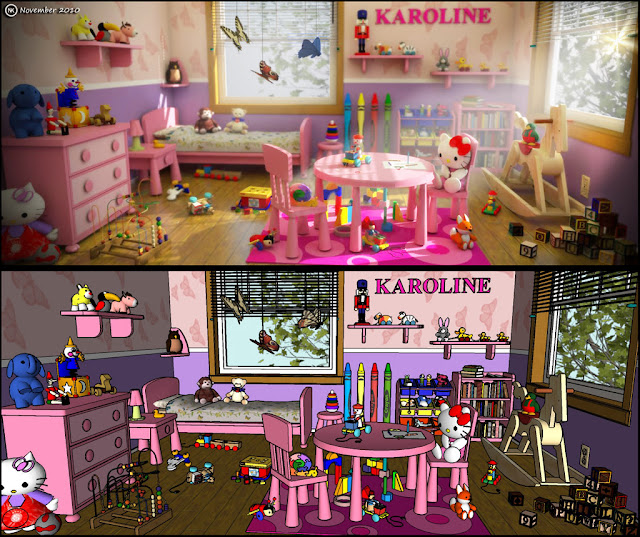Ken Nguyen is a very well known concept artist based in the USA. He is one of the most admired SketchUp users and you will know why by looking at his work. Though busy, were glad to be accommodated by Ken with this Q and A. Let as also use this opportunity to feature Ken Nguyen's work here at SketchUp Vray Resources. Thank you Ken Nguyen.
All images are courtesy of Ken Nguyen, and some of them were exclusively posted in this site.
SVR: Tell us more about Ken Nguyen.
KN: I
was born in Vietnam but left the country when I was 4 years old. I grew
up and lived in Paris, France, for 15 years before finally relocating
in the USA. I studied Architecture and worked as an Architectural
designer for about 5 years before quitting my job to follow my dreams of
working for the game and movie industries. I moved to San Francisco to
attend the Academy of Art University in 2003 and obtained a MFA in Games
(Modeling, Texturing, and Animation). I have been working as a Concept
Artist for the last 6 years. As a Concept Artist, I am responsible for
conceptualizing in 2D and 3D a wide range of the game’s artwork,
including props, characters and creatures, weapons and armors,
environments and architecture.
| Concept design_Jail |
 |
| HIgh Elf Architecture_interior Hall |
 |
| Sci-Fi Vehicle |
 |
| Mech Design |
 |
| Moonshade Garden |
SVR: How long have you been using Sketchup?
KN: I started using Sketchup when it came out back in 2000. It was developed by @Last Software at the time, before Google acquired it in 2006. It was already used a lot by architects and it is now very popular with 2d and 3d artists in the entertainment industry.
SVR: We know you use SketchUp intensively with your concept art and game modeling, can you please tell us more how you use it in your workflow.
KN: I start sketching on paper then build the model in Sketchup by adding details and textures. After that, I do a render with Vray for Sketchup and post work with Photoshop. Other times, I print out the Sketchup model with black lines and white background, then overlay with a tracing paper to add details that would take longer to do in Sketchup. When the concepts are approved, I clean the Sketchup models (Mostly architectural buildings) and export them into Maya for use by the modelers on the Art team.
SVR: Why did you choose it instead of other 3d software?
KN: I have used Maya and Max, but SketchUp is still my program of choice for building quick models. I love SketchUp because it is so fast and intuitive. It is like thinking and drawing in 3D. It’s a perfect tool for visualizing architectural ideas as well as anything that crosses one’s mind. With all the great plugins that are available for free or at a really affordable cost, the sky is the limit.
SVR: Do you have secret in managing your polygons in SketchUp?
KN:
I don’t really think too much about polygon count when I work on concepts. I try to focus on the design and making something really cool without the limitation of polygons. Having a powerful machine does help. Indeed, my home computer is an Alienware Aurora with i7-3930K CPU @ 3.20GHz with 1.25GB NVIDIA GeForce GTX 560 Ti and 16GB Quad Channel DDR3. However, if your machine is slow, here are a few suggestions to manage your polygon count as well as keep your file smaller:
- Small details need to be modeled with less polygons.
- Model only things that you will see in your final render. If you won't show the interior or the back of a building, then don't make them.
- Simply your circles with less segments.
- Delete Inner Faces with the plugin of the same name.
- Purge components with the Purge plugin.
- Clean up model by deleting Coplanar Edges and Lonely Edges

SVR: What was your favorite project so far? Why?
KN: I have to say the Starship for the EVE Online Contest. It took me 3 weeks working a few hours each night to complete it. The model is almost 1km in length and has over 2 millions polygons with a crazy amount of details. It is probably the most detailed model I ever did. I really learned a lot while building it by trying different plugins to boost the modeling process.
SVR: Do you have any advice to our readers who want to pursue SkechUp as tool in concept art and games?
KN: Do what you love and focus on one area first before trying to do everything. Think quality, not quantity. It is better to have a few great models rather than tons of mediocre ones.
Go to different forums to ask questions, see tutorials or get inspired my other artits’ works. (Sketchucation, Sketchupartists, CG society, CG talk, ChaosGroup, Cornucopia3D, itsartmag, 3dtotal, Evermotion, 3dm3, cgchannel, SVR).
If you can afford, buy a 3D mouse from 3D Connexion. Look for plugins in the Sketchucation plugin forum. The 3D mouse and the plugins will certainly increase the modeling speed. As for rendering, learn any of the rendering engines for Sketchup (e.g. Vray, Podium, etc.), and of course Photoshop (or any other similar software) for post work. I believe that all renders look great only because of post work. It's rare to find a 100% raw render without post work that looks great.
For concept artists focusing on environment and architecture specifically, you should learn the basic of design, color theory, composition and history of architecture and interior design.
Again, do what you love and practice, practice and practice. Practice makes perfect.
SVR. Thank You Ken Nguyen!




















impressive...
ReplyDeleteNossa muito bom
ReplyDeleteLooks amazing! Great work!
ReplyDelete